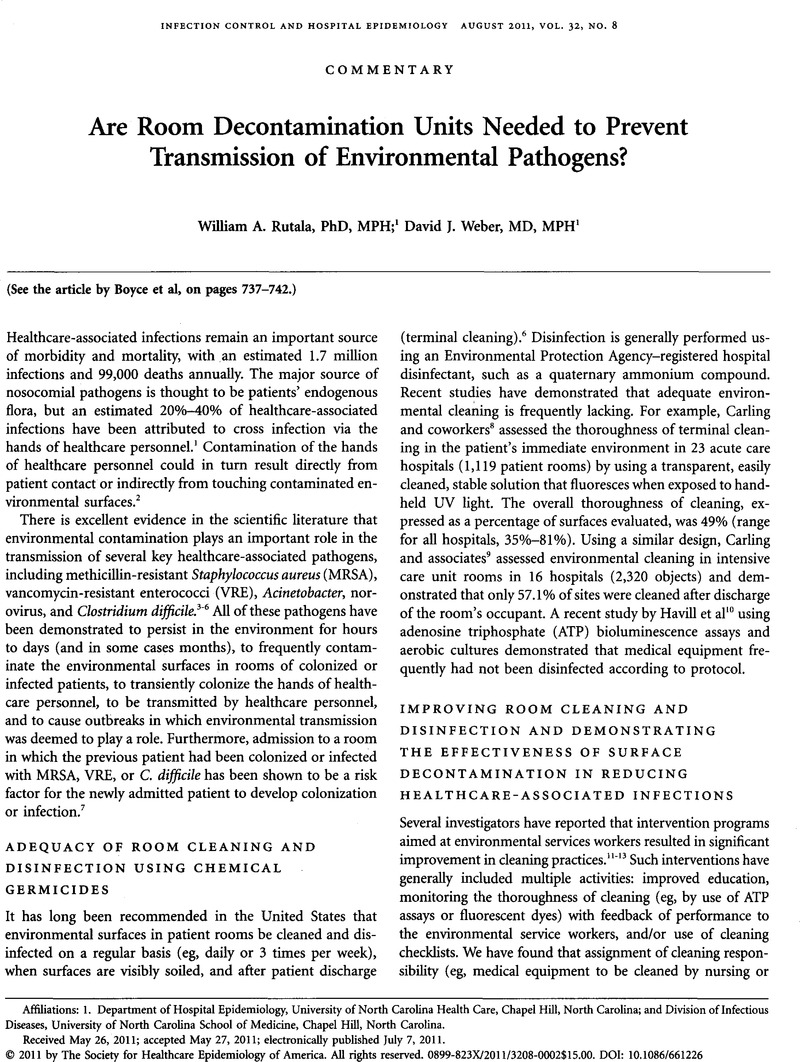Crossref Citations
This article has been cited by the following publications. This list is generated based on data provided by Crossref.
Rutala, William A.
Gergen, Maria F.
and
Weber, David J.
2012.
Efficacy of Different Cleaning and Disinfection Methods against Clostridium difficile Spores: Importance of Physical Removal versus Sporicidal Inactivation.
Infection Control & Hospital Epidemiology,
Vol. 33,
Issue. 12,
p.
1255.
Weber, David J.
and
Rutala, William A.
2012.
Self-Disinfecting Surfaces.
Infection Control & Hospital Epidemiology,
Vol. 33,
Issue. 1,
p.
10.
Havill, Nancy L.
Moore, Brent A.
and
Boyce, John M.
2012.
Comparison of the Microbiological Efficacy of Hydrogen Peroxide Vapor and Ultraviolet Light Processes for Room Decontamination.
Infection Control & Hospital Epidemiology,
Vol. 33,
Issue. 5,
p.
507.
Munoz-Price, L. Silvia
Fajardo-Aquino, Yovanit
and
Arheart, Kristopher L.
2012.
Ultraviolet Powder versus Ultraviolet Gel for Assessing Environmental Cleaning.
Infection Control & Hospital Epidemiology,
Vol. 33,
Issue. 2,
p.
192.
Weber, David J.
and
Rutala, William A.
2012.
Self-Disinfecting Surfaces.
Infection Control & Hospital Epidemiology,
Vol. 33,
Issue. 1,
p.
10.
Otter, J.A.
Yezli, S.
Perl, T.M.
Barbut, F.
and
French, G.L.
2013.
The role of ‘no-touch’ automated room disinfection systems in infection prevention and control.
Journal of Hospital Infection,
Vol. 83,
Issue. 1,
p.
1.
Weber, David J.
and
Rutala, William A.
2013.
Self-disinfecting surfaces: Review of current methodologies and future prospects.
American Journal of Infection Control,
Vol. 41,
Issue. 5,
p.
S31.
Rutala, William A.
and
Weber, David J.
2013.
Role of the hospital environment in disease transmission, with a focus on Clostridium difficile.
Healthcare infection,
Vol. 18,
Issue. 1,
p.
14.
Abreu, A. C.
Tavares, R. R.
Borges, A.
Mergulhao, F.
and
Simoes, M.
2013.
Current and emergent strategies for disinfection of hospital environments.
Journal of Antimicrobial Chemotherapy,
Vol. 68,
Issue. 12,
p.
2718.
Humphreys, Hilary
Winter, Bob
and
Paul, Mical
2013.
Infections in the Adult Intensive Care Unit.
p.
25.
Weber, David J.
and
Rutala, William A.
2013.
Understanding and Preventing Transmission of Healthcare-Associated Pathogens Due to the Contaminated Hospital Environment.
Infection Control & Hospital Epidemiology,
Vol. 34,
Issue. 5,
p.
449.
Levin, Joanne
Riley, Linda S.
Parrish, Christine
English, Daniel
and
Ahn, Sehoon
2013.
The effect of portable pulsed xenon ultraviolet light after terminal cleaning on hospital-associated Clostridium difficile infection in a community hospital.
American Journal of Infection Control,
Vol. 41,
Issue. 8,
p.
746.
Carling, P.C.
2013.
The need for clinically relevant studies of non-touch disinfecting systems.
Journal of Hospital Infection,
Vol. 84,
Issue. 4,
p.
340.
Weber, David J.
Anderson, Deverick J.
Sexton, Daniel J.
and
Rutala, William A.
2013.
Role of the environment in the transmission of Clostridium difficile in health care facilities.
American Journal of Infection Control,
Vol. 41,
Issue. 5,
p.
S105.
Otter, Jonathan A.
Yezli, Saber
Salkeld, James A.G.
and
French, Gary L.
2013.
Evidence that contaminated surfaces contribute to the transmission of hospital pathogens and an overview of strategies to address contaminated surfaces in hospital settings.
American Journal of Infection Control,
Vol. 41,
Issue. 5,
p.
S6.
Rutala, William A.
Gergen, Maria F.
Tande, Brian M.
and
Weber, David J.
2013.
Rapid Hospital Room Decontamination Using Ultraviolet (UV) Light with a Nanostructured UV-Reflective Wall Coating.
Infection Control & Hospital Epidemiology,
Vol. 34,
Issue. 5,
p.
527.
Passaretti, Catherine L.
Otter, Jonathan A.
Reich, Nicholas G.
Myers, Jessica
Shepard, John
Ross, Tracy
Carroll, Karen C.
Lipsett, Pam
and
Perl, Trish M.
2013.
An Evaluation of Environmental Decontamination With Hydrogen Peroxide Vapor for Reducing the Risk of Patient Acquisition of Multidrug-Resistant Organisms.
Clinical Infectious Diseases,
Vol. 56,
Issue. 1,
p.
27.
Fernando, Francine da Silva e Lima de
Ferreira, Adriano Menis
Colombo, Tatiana Elias
Rubio, Fernando Gôngora
and
Almeida, Margarete Teresa Gottardo de
2013.
Contaminação por fungos antes e após limpeza e desinfecção de colchões hospitalares.
Acta Paulista de Enfermagem,
Vol. 26,
Issue. 5,
p.
485.
Rutala, William A.
and
Weber, David J.
2013.
Disinfectants used for environmental disinfection and new room decontamination technology.
American Journal of Infection Control,
Vol. 41,
Issue. 5,
p.
S36.
Havill, Nancy L.
2013.
Best practices in disinfection of noncritical surfaces in the health care setting: Creating a bundle for success.
American Journal of Infection Control,
Vol. 41,
Issue. 5,
p.
S26.





